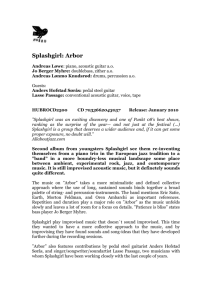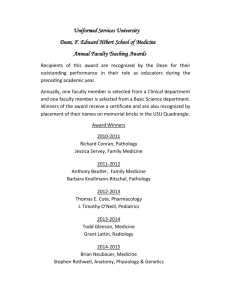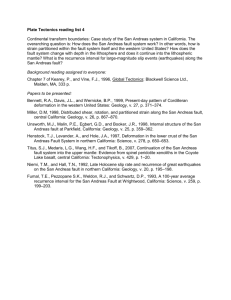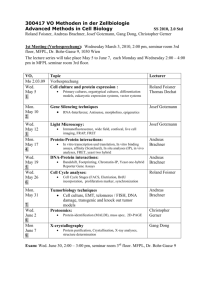Biomedical Engineering
advertisement
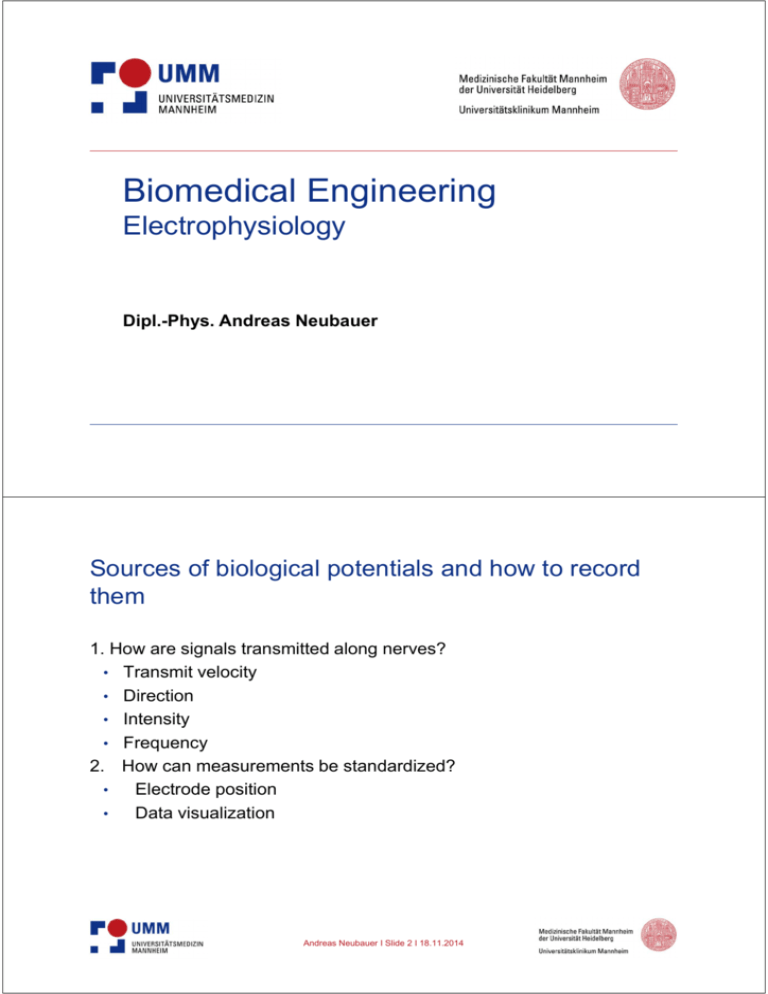
Biomedical Engineering
Electrophysiology
Dipl.-Phys. Andreas Neubauer
Sources of biological potentials and how to record
them
1. How are signals transmitted along nerves?
• Transmit velocity
• Direction
• Intensity
• Frequency
2. How can measurements be standardized?
•
Electrode position
•
Data visualization
Andreas Neubauer I Slide 2 I 18.11.2014
The nervous system
Andreas Neubauer I Slide 3 I 18.11.2014
Organization of the nervous system
• brain, nerves and muscles are the major components of the nervous
system
• sensory/afferent nerves
deliver information to the
brain
• information is passed along
motor/efferent nerves by the
brain
• the nervous system is highly
Brown, Medical Physics
parallel
• synapses allow reflex loops via the spinal column
⇒ can be suppressed by the brain
Andreas Neubauer I Slide 4 I 18.11.2014
Synapses
Neurons
• basic concept of nerves
• dendrites can be considered as the
means of information input
• axons are the channels for output
information
• cell bodies may be considered to be
located in the brain/spinal cord
• axons supply muscles or carry
information to the brain
Brown, Medical Physics
http://www.biotele.com/research.htm
Andreas Neubauer I Slide 5 I 18.11.2014
Neural communication I
• electrical signals in the body are constant in amplitude and vary in
frequency
⇒ pain intensity is regulated by the frequency of the signals
• normal frequency ≈ 1
(pulse per second)
• relation of frequency and intensity is approx. logarithmic
⇒ ( ) = log( ( )) + Brown, Medical Physics
Andreas Neubauer I Slide 6 I 18.11.2014
Neural communication II
• Example:
• Dynamic range of the ear: min 10 /1
⇒ 120
⇒ The eye is sensitive to a similarly wide range of intensities
• Assume a linear relationship:
= × ( )
• Maximum transmission frequency: 100 pps
⇒ min. sensory input would correspond to 10 ⇒ impractical!
⇒ with a logarithmic scale a dynamic range of 10 /1 is compressed to
25/1
⇒ recognition of different amplitudes is much worse
Andreas Neubauer I Slide 7 I 18.11.2014
Why is smooth movement possible?
Brown, Medical Physics
• increasing contraction is achieved be an increase in frequency
• not all muscle fibers twitch simultaneously
Andreas Neubauer I Slide 8 I 18.11.2014
The Nernst equation
• consider a reservoir with de-ionized
water
• add a volume with saline solution
(
) enclosed by a semipermeabel
(for
) membrane
• diffusion will go on until equilibrium is
established
Nernst equation:
=
!
&
log % '
"# $
&(
≈
diffusion gradient
electrostatic force
Brown, Medical Physics
)*
&
log+, ' ("#
&(
)
valid at room
temperature
.: Gas constant; /: Temperature; 0: Faraday constant;
12 : Valence
⇒ transmembrane potential with respect to the outside of the
membrane
Andreas Neubauer I Slide 9 I 18.11.2014
Transmembrane potential
4
•
ions can hardly diffuse through the membrane when the cell is in
resting state
4 influx
• generation of a nerve action potential leads to
• normally negative when the nerve is in resting state
Ion
Intracellular
concentration (56)
84
4
Extracellular
concentration (56)
Nernst potential
inside wrt
outside (57)
400
20
−75
50
450
+55
40
550
−66
Brown, Medical Physics
Andreas Neubauer I Slide 10 I 18.11.2014
Membranes and nerve conduction
• electrical impulses can travel
along the nerve with a velocity
of 50-/
• high/low intracellular
potassium/sodium
concentration is established by
the membrane ⇒ polarization
i.e. resting potential
4
>?4
=
Brown, Medical Physics
• stimulation leads to an efflux/influx of potassium/sodium
⇒ change in transmembrane potential
⇒ avalanche effect
⇒ DEPOLARIZATION!
Andreas Neubauer I Slide 11 I 18.11.2014
Transmission of Nerve Action Potentials (NAPs) I
• impulse of depolarization
which travels along a nerve
• muscle fibers can also
transmit action potentials
(MAPs)
• ionic currents will flow from
depolarized to polarized
parts
⇒ source of bioelectric
signals!
• myelinated fibers transmit
APs 10 times faster than
non-myelinated fibers
Brown, Medical Physics
Andreas Neubauer I Slide 12 I 18.11.2014
Transmission of NAPs II
• speed of transmission
depends on:
• Membrane
capacitance
• Myelin
Brown, Medical Physics
• Axon resistance
• assume a cylindrical membrane with diameter @ and length A:
BC
⇒ . = F; G: resistivity [Ωm]
DE
⇒ = LMDL; L: dielectric constant of neural membrane
⇒ . =
BV
WDE
DEF
= GL
DWF
;
X
RS
TU
time constant of the membrane [ ]
YZ
• typical values: Membrane capacitance: 1 F , @ = 10]-, A =
[U
10--, ^ ≈ 1Ω⇒ ≈ 3 × 10 ` ]F, . ≈ 1.3 × 10* Ω,time constant ≈ 0.4
⇒ .[c22%d ≈ 2.14Ω
Andreas Neubauer I Slide 13 I 18.11.2014
Muscle Action Potentials (MAPs)
Brown, Medical Physics
Smooth muscle
Striated/voluntary muscle
intestines and blood vessels
skeletal muscle
intrinsically active
voluntarily active
Andreas Neubauer I Slide 14 I 18.11.2014
Volume conductor effects I
hi
+
g
Df d
• electrical potential: Φ =
• assumptions:
• Potential at infinity equal zero
• Tissue is homogeneous
l
j = k gd
⇒
B
Dd F
j =
Bh
Dd
• cylindrical nerve fiber:
⇒
j =
Bmn op
Dq
Brown, Medical Physics
• contribution made to the potential field at r(s‘, u‘, v‘)
⇒ j = s– s‘
x
⇒ Φ s, u, v = g
+ u − u‘ x + v − v‘
Bhn p
y
D p p z F 4{ zF 4| zF F
x
y
F
s
Andreas Neubauer I Slide 15 I 18.11.2014
Volume conductor effects II
• connection of kU to the transmembrane potential
⇒ kU s = k} –kc =
[T p
T p op ~
Bop
−
[T p4op
T p ~
Bop
Brown, Medical Physics
=
x~ o F T
B op F
FT
Brown, Medical Physics
Brown, Medical Physics
Andreas Neubauer I Slide 16 I 18.11.2014
Detection and analysis
of ECG/EKG
Andreas Neubauer I Slide 17 I 18.11.2014
ECG/EKG characteristics
• electrical events can be recorded
from the body surface
⇒ complex relation to the source
• lighthouse analogy
• recording is only possible when
potentials are changing
⇒ record of the changing activity
of the heart
Brown, Medical Physics
Andreas Neubauer I Slide 18 I 18.11.2014
Electrocardiographic planes
• standardization of recorded signals is needed
Brown, Medical Physics
Andreas Neubauer I Slide 19 I 18.11.2014
The frontal plane ECG/EKG – lead configurations
• electrical activity of the heart can be described as movement of an
electrical dipole
⇒ cardiac vector is the line joining the charges of the dipole
• Einthoven‘s triangle: triangle between RA, LA and LL
⇒ lead configurations:
⇒ Lead I: RA (−) to LA (+)
⇒ Lead II: RA (−) to LL (+)
⇒ Lead III: LA (−) to LL(+)
• plotting the measured signal in the three leads at any time of the
cardiac cycle on Einthoven‘s triangle leads to the cardiac vector
• body build and age influence the cardiac vector
Andreas Neubauer I Slide 20 I 18.11.2014
The transverse plane ECG/EKG
Brown, Medical Physics
• recorded unipolarly wrt an indifferent electrode (LA + RA + LL)
• usually with six electrodes in a line round the chest
Andreas Neubauer I Slide 21 I 18.11.2014
The sagittal plane ECG/EKG
• also recorded with an
indifferent electrode
• catheter with electrode is
placed down the oesophagus
• rarely used in practice
http://www.cardiocommand.com/research_cathinsert.html
Andreas Neubauer I Slide 22 I 18.11.2014
Electrodes and amplifiers
• good skin preparation leads to an electrode impedance < 10 Ω
⇒ amplifier input impedance of 1€Ω is adequate
⇒ electrodes do not have the same impedances
⇒ common-mode voltage is produced
⇒ 80
common-mode rejection with 10 Ω difference impedance
between electrodes requires a common-mode input impedance of
100€Ω
• normally the majority of EMG spectra lies above the ECG spectra
⇒ apply bandpass filter
Andreas Neubauer I Slide 23 I 18.11.2014
Detection of EEG signals
Andreas Neubauer I Slide 24 I 18.11.2014
Sources of the EEG signal
• electroencephalographic signals were first recorded in 1929 (ECG/EKG
in 1895)
• electroencephalograph means graph of electrical changes from the
enkephalos (Greek for brain)
• sources of the EEG signals are the neuronal potentials of the brain
⇒ attenuation by bone, muscle and skin
⇒ electrocorticography (ECoG) records signals directly from the
cortex
• EEG signals are between 10 and 300]V
• Ag-AgCl discs are best to record an EEG
⇒ time consuming
⇒ skullcaps are much more convenient in use
Brown, Medical Physics
Andreas Neubauer I Slide 25 I 18.11.2014
EEG equipment and settings
• differential amplifiers are used for signal amplification
• min. eight channels at the recorder
• assume 16 differential amplifiers ⇒ 32 input connections plus one earth
connection
• „standard“ EEG settings:
• Chart speed 30--/
• Gain setting: 100]V/ƒ• Time constant: 0.3 (corresponds to a −3 point of 0.531/ )
• Filters: High frequency response is a -3 at 751/
• electrode impedance < 10 Ω
Andreas Neubauer I Slide 26 I 18.11.2014
Normal EEG signals
• a quiet environment is
required
• only one person should be
in the room with the patient
• wide-awake „normal“
persons produce an
unsynchronized highfrequency EEG
• rhythmic activity
at8– 131/ is produced if
a „normal“ person closes
the eyes
Brown, Medical Physics
Andreas Neubauer I Slide 27 I 18.11.2014
Artifacts
• electrode artifacts
⇒ electrode impedances
⇒ interference
⇒ movement of the cables
⇒ perspiring of the patient
• potential difference of several between the back and front of the
eyes
• ECG may be seen if recording
electrodes are spaced a long way
• dental fillings may produce artifacts
http://www.psychologie.uzh.ch/fachrichtungen/plasti/Lab
or.html
http://bipolaraspiemom.wordpress.com/20
11/07/15/are-you-still-awake-our-eegstory/
Andreas Neubauer I Slide 28 I 18.11.2014

